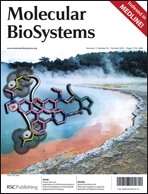Streptococcus mutans, the main pathogen involved in the development of dental caries, is an aerotolerant microorganism. The bacterium lacks cytochromes and catalase, but possesses other antioxidant enzymes, such as superoxide dismutase (SmSOD). Previous researches suggested that SmSOD belongs to the ‘cambialistic’ group, functioning with Fe or Mn in the active site. A recombinant SmSOD (rSmSOD) with a His–tail has been produced and characterised. Studies on metal uptake and exchange proved that rSmSOD binds either Fe or Mn as a metal co-factor, even though with a consistent preference for Fe accommodation. The analysis of several enzyme samples with different values of the Mn/Fe ratio in the active site proved that the type of metal is crucial for the regulation of the activity of rSmSOD. Indeed, differently from the significant preference for Fe displayed by the enzyme in the binding reaction, its Mn-form was 71-fold more active compared to the Fe-form. The rSmSOD was endowed with a significant thermostability, its half-inactivation occurring after 10 min exposure at 71 or 73 °C, depending on the bound metal. Moreover, the enthalpic and entropic contribution to the heat inactivation process of rSmSOD were strongly regulated by the Mn content of the enzyme. The effect of typical inhibitors/inactivators has been investigated. rSmSOD was inhibited by sodium azide, and its sensitivity increased in the presence of higher Mn levels. Concerning two physiological inactivators, the enzyme displayed a different behaviour, being quite resistant to hydrogen peroxide and significantly sensitive to sodium peroxynitrite. Furthermore, the Mn co-factor had an amplifying role in the regulation of this different sensitivity. These results confirm the cambialistic nature of SmSOD and prove that its properties are regulated by the different metal content. The adaptative response of S. mutans during its aerobic exposure in the oral cavity could involve a different metal uptake by SmSOD.

You have access to this article
 Please wait while we load your content...
Something went wrong. Try again?
Please wait while we load your content...
Something went wrong. Try again?


 Please wait while we load your content...
Please wait while we load your content...